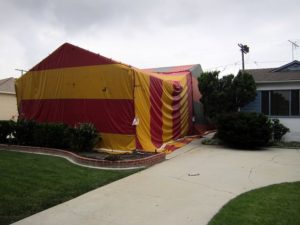Read and Learn More About Pests
When Is Household Fumigation Necessary? Advanced pest removal practices are required to combat serious infestations. Fumigation, also sometimes called tenting, is one advanced method of pest removal that is necessary for the removal of certain types of pests, including specific breeds of termites. Read on to find out more information on fumigation and the proper steps required before and after the process takes place.
Advanced pest removal practices are required to combat serious infestations. Fumigation, also sometimes called tenting, is one advanced method of pest removal that is necessary for the removal of certain types of pests, including specific breeds of termites. Read on to find out more information on fumigation and the proper steps required before and after the process takes place.
What is Household Fumigation?
Fumigation takes place by raising a tent around the home. This tent is then filled with fumes that are toxic, not just to termites but also to humans and pets. For this reason it is necessary for homeowners and pets to leave the home when the process takes place. Depending on the strength of of fumes you may be required to evacuate the property for several days. You also must take special care to prepare the home and items within it for this process.
Preparing Your Home for Fumigation
Seal any opened packages of food in airtight bags that are specified as being safe for use in fumigation. Nylofume bags are the most commonly recommended type of bag for this use. The only items that are left out during fumigation are those which are packaged in glass, plastic or metal containers and still have the original manufacturer’s seal in tact.
When preparing for a fumigation in your home take special note of the following items:
-
Food that’s stored in plastic bags or containers (including pasta, rice and other dry goods)
-
Any food item, open or new, that’s stored in a cardboard container (such as cereal)
-
Fresh produce
-
Items stored in re-sealable containers (like butter, cream cheese, or leftovers)
-
Items that are stored in containers with openings, such as salt and pepper shakers, where air or fumes can easily travel inside
-
Pet food
-
Houseplants
Items That Do Not Need to Be Removed:
-
Cosmetics and toiletries like shampoos and soaps
-
Unopened cans
-
Unopened bottles, though they should be stored lying down during fumigation
You should leave cabinet doors, blinds and drapes open so that fumes can find their way into hard to reach areas. Do not leave any doors locked throughout your home, it is important that fumes must be able to find their way through and out of every room in the house.
Reentering The Home Following Fumigation
Once fumigation has been completed you should consult with the pest control provider about the proper steps you need to take before returning to your everyday life. Most treatments only require you to be outside of the home for 15 to 30 hours following fumigation. The technicians are legally required to inspect your home for safety using specific monitoring devices prior to your return, and levels of fumigant must be below EPA-regulated levels.
Depending on the specific chemicals that are used during the fumigation you may need to rewash your dishes and linens before using them. Be sure to request extremely detailed instructions from the provider who will be performing the fumigation.
Additional considerations may need to be taken into account before household fumigation takes place. Whether or not you’ll need use of your neighbor’s yard for the tent to be properly set up. Shrubs that have been planted less than a foot from the house may also be affected by the process, as they may have to be left inside of the tent, which could lead to the death of the plant.
The fumes that fill your home during this process can be extremely toxic, so take your time when selecting a pest control provider to complete this process. Only select a provider that has a long history of success with fumigation. Customer testimonials and reports from the Better Business Bureau are two of the best ways to learn about the company’s history of customer satisfaction.
More Pest Control Solutions
Read Reviews
Read reviews by other customers like you.
Research
Tips and articles to help you select a pest control provider.
Find Providers
Find a qualified pest control provider in your area.

